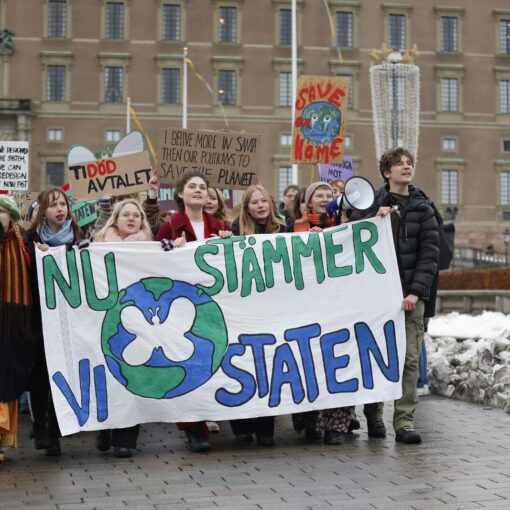In the first months of 2024, legislators in four states—Maryland, Massachusetts, New York, and Vermont—have pushed for legislation that would collectively require large fossil fuel producers and refiners to pay for hundreds of billions of dollars of state-level climate adaptation infrastructure. E&E News reports that similar legislation may soon be introduced in California and Minnesota.
These state-level “Climate Superfund” bills are modeled on the Comprehensive Environmental Response, Compensation, and Liability Act of 1980 (CERCLA), commonly known as Superfund, which imposes liability on multiple parties, including the generators of waste, for the cleanup of contaminated sites. Since as early as 1992, some academics have pointed to CERCLA as a model for pooling funds from greenhouse gas (GHG) emitters to remedy or mitigate climate change impacts. The Climate Superfund bills currently being considered by several state legislatures aim to do just that, taking the long-standing “polluter pays principle,” and extending it beyond traditional hazardous pollution of water or land to include GHG emissions. Under the CERCLA approach adopted by the Climate Superfund bills, large fossil fuel producers and refiners are held strictly liable for costs arising from their products’ GHG emissions, regardless of whether they are deemed to have acted improperly.
The Climate Superfund bills have already attracted vicious opposition from the fossil fuel industry and its political allies and, if passed, will inevitably face vigorous legal challenges. This post outlines the likely contours of these lawsuits, and the features of the Climate Superfund bills that may make them vulnerable to, or resilient against, such challenges.
The Scientific Basis for State Action
The Climate Superfund bills are closely tied to the growing body of climate attribution science, “the branch of science that seeks to isolate the effect of human influence on the climate and related earth systems.” Although most attribution research is concerned with the aggregate effect of human activities on the climate system, a growing number of studies in a subfield of attribution science, known as “source attribution,” provide critical insights on the question of who is responsible for climate change-related harms – for example, by quantifying the historical emissions contributions of specific countries, sectors, and companies, and by estimating source-specific contributions to phenomena such as global mean temperature increase and sea level rise.
In a 2022 press release introducing New York’s then-unprecedented Climate Superfund bill, one of the bill’s sponsors directly stated that the bill was inspired by source attribution research (specifically, research on carbon dioxide and methane emissions attributable to fossil fuel and cement producers). More recent reporting around the four Climate Superfund bills has credited attribution science with giving state lawmakers “a foundation to link the biggest companies to specific disasters.” Attribution science will also play a key role in implementing these Climate Superfund bills if they ultimately pass. Each of the four bills in Maryland, Massachusetts, New York, and Vermont directs the relevant state agency to “use the best available science” to identify high-emitting entities and apportion liability among them.
Assessing State Proposals for Climate Superfunds
The bills introduced in Maryland, Massachusetts, New York, and Vermont are modeled on, and closely resemble, one another. However, the four bills diverge in some key areas that may impact their implementation and resilience against judicial challenges.
Proposed Program and Use of Funds
Each of the Climate Superfund bills seeks to recover costs from the highest-producing fossil fuel companies, and each bill directs recovered money towards the creation of state-managed funds to pay for infrastructure that is “designed to avoid, moderate, repair or adapt to negative impacts of climate change, or to assist communities, households and businesses in preparing for future climate change-driven disruptions.” Tying the proposed bills to state expenditures, rather than damages, avoids one of the more difficult tasks in climate change attribution—assigning a specific dollar value to the damages attributable to a particular entity. However, state lawmakers may still need to justify cost recovery estimates and could potentially do so by using attribution research into state-level climate impacts and adaptation costs to show that certain damages are attributable to climate change and the costs states incur as a result.
Liable Entities
The four Climate Superfund bills identify liable fossil fuel companies based on the aggregate GHG emissions of their products, expressed in carbon dioxide equivalent (CO2-equivalent) emissions, a common emissions measurement that is weighted for the different global warming potentials of different substances. The bills target the same set of entities: companies that extracted, produced, or refined fossil fuels during the covered period, and whose products resulted in more than one billion metric tons of CO2-equivalent GHG emissions (for convenience, “Super-emitters”). Each bill addresses emissions over roughly the same period—2000 to 2018 in Maryland, Massachusetts, and New York, and 2000 to 2019 in Vermont. Each bill also limits its reach to Super-emitters with “sufficient connection with the State to satisfy the nexus requirements of the U.S. Constitution.” This provision addresses two related Constitutional concepts, Due Process and the Dormant Commerce Clause, which are discussed in more detail below.
Cost Assessment and Allocation
The four Climate Superfund bills take the same general approach to liability: each bill imposes strict liability on the largest fossil fuel companies for a portion of the state’s climate-related adaptation expenses, in proportion to the emissions associated with the products that each company produced or refined. However, the Climate Superfund bills proposed in the four states have subtle differences that may impact their implementation and interpretation by courts.
The Massachusetts, Maryland, and New York Climate Superfund bills are each designed to accomplish a set amount of “cost recovery”—$75 billion each for Massachusetts and New York, and $9 billion for Maryland. The New York bill contains proposed legislative findings, which include that “[t]he cost to [New York State] of climate adaptation investments through 2050 will easily exceed $150 billion, far more than the $75 billion being assessed on the fossil fuel industry.”[1] In contrast, it is unclear how the authors of the Massachusetts and Maryland bills reached their respective assessments of $75 billion and $9 billion.
All three bills allocate the total cost recovery among the Super-emitters based on their “covered emissions,” defined as all GHG emissions exceeding 1 billion metric tons of CO2-equivalent emissions between 2000 and 2018. While this approach offers legislators some certainty as to the total amount of cost recovery, it has the potential to result in some unusual cost distributions at the margins. For example, under this formula a Super-emitter whose products emitted 1.2 billion tons of GHGs during the relevant period would be required to pay twice as much as an entity responsible for 1.1 billion tons.
The Vermont Climate Superfund bill takes a significantly different approach to cost recovery. Instead of seeking a fixed cost assessment from the fossil fuel industry, the bill directs the Vermont Agency of Natural Resources to issue “cost recovery demands” to Super-emitters in proportion to the Super-emitter’s share of global 2000-2019 GHG emissions and the total cost to Vermont arising from GHGs emitted over that period. This approach directly ties the charges assessed against each Super-emitter to the costs its products impose on Vermont, but creates some uncertainty around the total amount Vermont may recover.
Potential Legal Challenges to State Climate Superfund Bills
Together, the four Climate Superfund bills seek hundreds of billions of dollars from the largest fossil fuel companies. These Super-emitters, along with sympathetic political and industrial organizations, states, and/or municipalities, will inevitably challenge the Climate Superfund bills in court. Plaintiffs will likely assert a variety of claims, and invoke an overlapping array of constitutional principles, that challenge both the authority of states to regulate GHG emissions and the proportionality and propriety of the Climate Superfund bills.
Federal Preemption and Authority to Regulate
Opponents of the Climate Superfund bills will likely argue that existing federal law like the Clean Air Act (CAA) preempts state regulation of GHG emissions. No federal statutes explicitly preempt state Climate Superfund laws, and different U.S. courts have reached different conclusions about whether states can impose liability for global GHG emissions. In a 2021 appellate decision, City of New York v. Chevron, the Second Circuit held that the City of New York could not sue global fossil fuel producers under state tort law for damages caused by fossil fuel emissions outside of its borders. The Second Circuit held that these state common law claims were preempted by federal common law, which was itself displaced by the CAA. In 2023, the Supreme Court of Hawaii held the opposite in City & County of Honolulu v. Sunoco. The Supreme Court may soon have the final word on the issue of preemption as the Sunoco defendants have since petitioned for certiorari. It is of note that the precedent concerns common law claims and courts may approach state statutes differently. Moreover, the Second Circuit’s reasoning in New York v. Chevron relied on the existing scope of federal GHG regulations. The Supreme Court recently restricted EPA’s authority to regulate GHGs under the CAA and may soon limit agency authority across the board by weakening or abolishing the Chevron doctrine. As EPA authority over GHG regulation is weakened, so too is the Second Circuit’s reasoning.
Preemption aside, opponents may also challenge the underlying power of state governments to make and enforce such broad laws. While each state generally has jurisdiction to regulate pollution that comes from sources within it, GHGs emitted across the world create both global and local harms. States may face two constitutional barriers to imposing liability for these harms. First, the Due Process Clause of the Constitution prevents states from imposing liability on parties that have not established sufficient “minimum contacts” with the state such that the state can fairly exercise authority over them. Second, the Commerce Clause limits the authority of states to take actions that affect national and international commerce. This principle broadly prevents states from regulating interstate economic activity unless that activity is closely tied to the interests of the regulating state. In the context of taxes, the Supreme Court has held that the Commerce Clause only permits states to levy a tax if it “(1) applies to an activity with a substantial nexus with the taxing State, (2) is fairly apportioned, (3) does not discriminate against interstate commerce, and (4) is fairly related to the services the State provides.”
The Climate Superfund bills consciously consider the limits of state authority, and each bill only seeks to recover costs from Super-emitters with “sufficient connection with the State to satisfy the nexus requirements of the U.S. Constitution.” In addition, the bills do not discriminate between in-state and out-of-state producers. These provisions may forestall challenges to the Climate Superfund bills themselves. However, individual Super-emitters that operate on a national or global scale will likely argue that their activities do not have a sufficient state connection to justify state regulation or establish state jurisdiction over the Super-emitter.
Fairness and Retroactivity
Opponents will also likely challenge the fairness of the Climate Superfund bills. The Due Process Clause of the Fourteenth Amendment provides both procedural and substantive protections against arbitrary or unfair punishments. While Due Process challenges can take many forms, courts assessing Climate Superfund bills will likely face three core questions:
- Are the Climate Superfund bills rationally furthering a legitimate legislative purpose?
- Is the liability imposed by the Climate Superfund bills “severely disproportionate” to the responsible parties’ actions or the resulting harm?
- If the Climate Superfund bills are deemed to impose retroactive liability or taxes, should the Super-emitters have “reasonably expected that [they] would be subject to regulation?”
While a comprehensive analysis of these complicated questions is beyond the scope of a single blog post, the history of CERCLA and the structures of the proposed Climate Superfund bills suggest that in answering these questions certain issues will be heavily litigated.
First, opponents will likely challenge the decision to hold them, and only them, responsible for the costs of state climate adaptation. Some representatives of the fossil fuel industry have already disputed the merits of attribution science, going so far as to characterize it as “a conspiracy of the Rockefeller Family Fund.” While challenges to attribution science may verge on the conspiratorial, opponents of the Climate Superfund bills may also argue that these bills hold only a small subset of GHG contributors liable for the harms of climate change. The Climate Superfund bills impose liability on a broad variety of fossil fuel producers and refiners, including state-owned companies. However, the Climate Superfund bills ignore emissions from other major sources of emissions, like agriculture, impose no liability on actors like the power plants or drivers who ultimately burned those fuels, and make no concession to the fact that the U.S. government encouraged the historical practices of Super-emitters through a range of policies that subsidized and supported fossil fuel production.
Another challenge could attack the liability structure of the Climate Superfund bills, and argue that states lack a rational basis for the total amount of liability assigned to each Super-emitter. The Due Process Clause restricts statutes that impose or limit liability for economic activity if they are “demonstrably arbitrary or irrational.” The Maryland, Massachusetts, and New York bills each seek to recover a set amount of money to fund climate infrastructure, and, as currently drafted, only the New York bill attempts (with little detail) to tie that amount to specific climate-related harms within the state. The bills then allocate this amount among the Super-emitters over which each state has jurisdiction, in proportion to the relative emissions from each Super-emitter’s products. These bills may be vulnerable to Due Process challenges because they do not clearly articulate a connection between these infrastructure costs and the harms caused by each liable Super-emitter to the state. While Climate Superfund states will likely argue that they have a legitimate interest in financing climate adaptation infrastructure, and could potentially use attribution and adaptation assessments to justify the costs allocated to each Super-emitter, it is unclear whether the states have already conducted such assessments.
The Vermont Climate Superfund bill has a different liability structure that may be more resilient against Due Process challenges. The Vermont bill directs the Vermont Agency of Natural Resources to identify the total harm to Vermont arising from GHGs emitted between 2000 and 2019 and assigns liability to Super-emitters based on their products’ share of global GHG emissions during that period. While this highly technical process could be difficult to implement, its detail may undercut claims of arbitrariness.
Finally, opponents are likely to argue that the Climate Superfund bills impermissibly impose retroactive liability. The Due Process Clause prevents states from retroactively imposing civil liability for previously permitted activities unless the responsible party “could have reasonably expected that it would be subject to regulation.” While the fossil fuel industry has made a point to characterize these liability regimes as retroactive taxes, taxes and environmental remediation fees are held to the same legal standard, and numerous retroactive taxes have been upheld by the Supreme Court.
Many courts have upheld the model of retroactive liability used by CERCLA, which seeks damages for past pollution from parties who created and profited from the pollution-generating activities. In the climate context, the historic regulation of air pollution paired with the fossil fuel industry’s long-standing and well-documented knowledge of their products’ climate impacts support the argument that Super-emitters could have reasonably expected to be held liable for these harms. However, plaintiffs may point to the numerous sources of global GHG pollution, ranging from governments to individual citizens, to argue that they could not have reasonably expected to bear all of the liability created by the Climate Superfund bills.
Conclusion
States around the country are suffering increasingly severe damage from climate change-driven disasters, and face enormous expenses associated with mitigating and adapting to the impacts of climate change. The four Climate Superfund bills currently under consideration in Maryland, Massachusetts, New York, and Vermont adopt a creative strategy to hold fossil fuel companies accountable for these costs.
If passed, the Climate Superfund bills will face immediate legal challenges. If these legal barriers are overcome, the Climate Superfund states will face the logistical hurdles of apportioning and enforcing liability among a large number of polluters, which has proven difficult but doable in traditional CERCLA cases. Even if the Climate Superfund bills are successful in recovering funds for state adaptation, it is not clear that these retroactive bills will meaningfully affect the future behavior of Super-emitters. While the Climate Superfund bills would be an enormous financial blow to Super-emitters (for context, in 2023 the largest U.S. energy companies, Exxon Mobil and Chevron, reported earnings of $36 billion and $21.4 billion, respectively), they, or their successors, may simply continue to extract and produce fossil fuels.
Whether the Climate Superfund bills succeed, they represent a broader trend of state governments taking action on climate change. As the harms of climate change become more apparent, governments will face increasing pressure to hold fossil fuel companies accountable for their role in the global crisis, and creative tools like the Climate Superfund bills will continue to emerge.
__________________________________________________________________________________________________________________
[1] It is perhaps interesting to note that the New York Climate Superfund bill, when first introduced, proposed a total assessment of only $30 billion.




